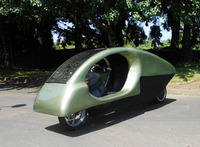Hydraulic Flywheel Energy Recapture Technology Being Advanced for Historic Eco-Friendly Vehicle
 |
Lane Motor Museum and Thrustcycle to Restore 1967 Science and Mechanics Vehicle with KERS
HONOLULU--March 15, 2013: Thrustcycle Enterprises LLC and the Lane Motor Museum are working to fulfill the promise of a vehicle built in 1967 called the Gyro-X, which featured a working hydraulic flywheel kinetic energy recovery system (KERS) forty years before the introduction of KERS to Formula One. Designed and engineered by famed automotive designer Alex Tremulis and gyroscopic systems expert Thomas Summers, the Gyro-X was featured on the cover of the September 1967 edition of Science and Mechanics.
Thrustcycle Enterprises LLC was contracted to rebuild the Gyro-X's flywheel/gyroscopic system and related control systems to function as originally intended. The rest of the vehicle is being restored by the Lane Motor Museum. The restoration is being done in commemoration of Alex Tremulis' 100th birthday anniversary in 2014.
The Gyro-X employed a hydraulic system within its gyroscopic system. Hydraulics are an effective medium for transferring energy, while flywheels are an efficient means of storing energy for short-term stop and go situations. "The Gyro-X was a vehicle well before its time," says Thrustcycle Enterprises' CEO Clyde Igarashi. "Not only was it an early demonstration of a gyro-stabilized vehicle, but it was also a very early example of a KERS capable vehicle." He continues:
Not many people know that the Gyro-X was designed to recycle kinetic energy via a hydraulic flywheel system back in 1967. The flywheel/hydraulic KERS might have been a byproduct of gyroscopic stability, but with today's energy and pollution challenges, it may very well be the most important technology in the Gyro-X.
Thomas Summers, who designed the car's gyroscopic system, was issued a U.S. patent for it in September of 1969. "The Gyro-X uses hydraulic controls and a gyroscopic system that is quite different from what we're building today for our other vehicles," says David Ryker, Thrustcycle's Chief Technical Director. "Hydraulics present certain challenges for us, while also allowing us to do some things better than with pure electrics. There is definitely a place for hydraulics in energy recapture for certain types of vehicles." Ryker is familiar with the system as he was advised for his own gyroscopic vehicle in the 1990's by Summers. He continues:
We're exploring the implementation of both hydraulic and electric KERS technology in vehicles that don't necessarily need gyroscopic stability, like 3 and 4 wheelers. These vehicles will benefit from the increased control and performance the gyros enable, while gaining the ability to recycle kinetic energy. The Gyro-X being demonstrated at the Lane Motor Museum is a great showcase for the technology.
Alexander Sarantos Tremulis (born on January 23, 1914) was a famed industrial designer who was inducted into the Automobile Hall of Fame in 1982. His illustrious career included positions in Cord Automobile, Duesenberg, General Motors, Tucker Car Corporation and Ford Motor Company. Tremulis designed the gyroscopically stabilized Gyro-X for Gyro Transport Systems Inc. He also designed a streamlined motorcycle Gyronaut X-1, which won the land speed record at Bonneville in 1966.
The Lane Motor Museum is home to rare and unique vehicles, as well as those that have been influential to the development of transportation. Boasting the largest collection of European vehicles in the U.S, the museum is located 3 miles form Downtown Nashville, TN. The Lane Motor Museum features a collection of 150 unusual cars and motorcycles not typically seen in the U.S.
Thrustcycle Enterprises LLC specializes in gyroscopic stabilization and control technology, and energy efficient transportation systems.


